Ice Hockey
Ice hockey is a team sports game played on ice. Its main purpose is to throw the puck into the opponent's twine more times than the opposing team does within the set period of time. The puck is passed from one player to another via the ice court with special hockey sticks. The team that has thrown a greater number of pucks into the opponent's twine is the winner.
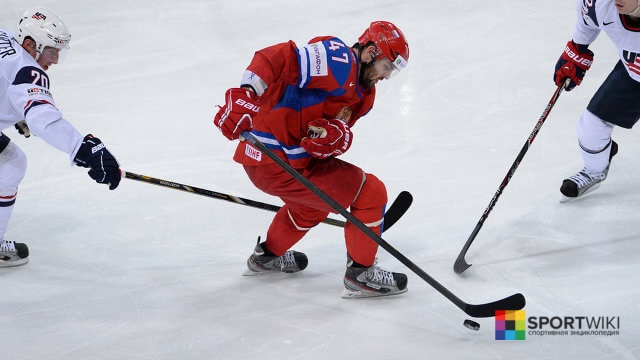
History of Ice Hockey
Disputes about where and when hockey appeared have not stopped to this day. Montreal (Canada) is considered to be the official place where modern hockey appeared. According to another popular opinion, hockey emerged in Holland. There exist the paintings of Dutch artists, dating back to the 16th century, which depicts people playing the game that is similar to hockey. But no matter what happened in Holland, the first officially recorded hockey match was played in Montreal, on Victoria skating rink on March 3, 1875.
Two years later, there were developed the first seven rules of hockey. In 1879, the wooden puck was replaced with its rubber counterpart. In 1886, the following improved rules of the game were organized and printed:
- the number of players has been reduced to seven;
- the whole game from the beginning till the end was played by the same participants of the teams;
- only injured players were allowed to be substituted after the consent of the opposing team.
The first professional hockey team was created in Canada in 1904. In the same year, the teams were reduced to six players. The standard size of the hockey rink was established. It was 56 × 26 m and has changed little since then. It became allowed to replace players not only because of injuries.
Later, Patrick brothers introduced a system for assigning a number to each player, a new scoring system, and marking the rink to divide it into certain zones. In 1945, multi-colored lights were installed near the twines to count the number of delivered pucks more accurately.
Ice Hockey Rules
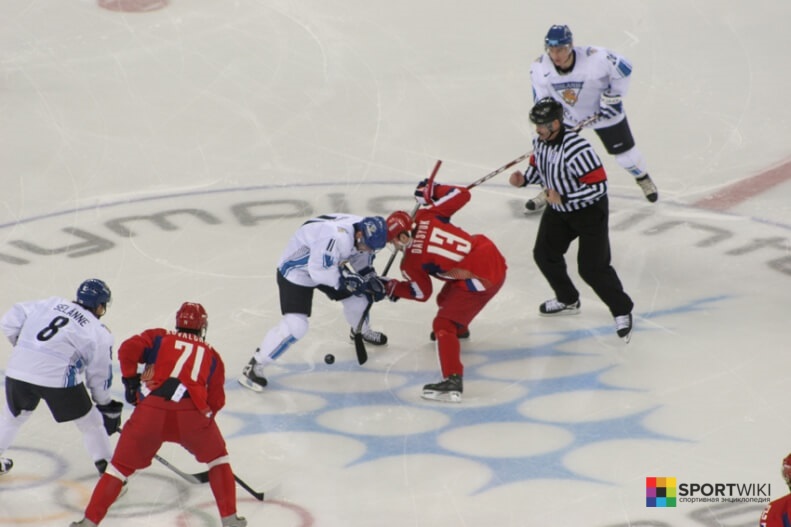
In the modern ice hockey rules, the following important points have been established:
- a hockey game consists of three 20-minute periods;
- each period begins with a faceoff, and ends with the referee's whistle;
- the faceoff is carried out by the referee;
- there are 15-minute breaks between the periods followed by a change of the goal;
- on the field, there can be only six players at the same time, although the number of people in the whole team can reach 20-25 people;
- players can be substituted both in the pauses and during the game;
- power fight is allowed in hockey;
- in power fight, the following techniques are prohibited: foot sweeps, delaying the opponent, elbow strikes, and also attacking a player who does not have the puck;
- the main time of the game may end in a draw and in such a case, the additional time should be assigned, after which penalty shoot-out may occur;
- for violations, the players are sent to the penalty box.
Ice Hockey Rink
The size of the hockey rinks can vary depending on the rules (NHL or IIHF). According to IIHF, the size of the hockey rink may vary from 56 to 60 meters in length and from 26 to 30 meters in width. In the NHL, the dimensions of the hockey rink are strictly established. The length of the rink must be 60.96 meters and its width must be 25.90 meters. It is believed that a small platform leads to a brighter game involving power fight, shots on goals, and the game at the sides.
The corners of the rink must be rounded forming an arc with the radius ranging from 7 to 8.5 meters according to the IIHF rules and it must be 8.53 meters in the NHL.
The rink must be fenced with the banking board the height of which must range from 1.20 to 1.22 meters. On the front banking boards behind the twine, across the entire field, there must be installed the fencing made of the protective glass. The height of this fencing must be from 1.6 to 2 meters.
Hockey rink must be marked in the following way:
- at the distance of 3–4 meters from the banking boards, there must be drawn end lines;
- at the distance of 17.23 meters from the end line, there must be drawn blue lines dividing the rink into 3 zones including the central zone and two rivals' ones;
- in the center of the rink, there must be a red line dividing the area in half; there must also be a faceoff spot in the middle of the red line;
- on both sides of the gate, at a distance of 6 meters, there must be faceoff points and a faceoff zone with a radius of 4.5 meters.
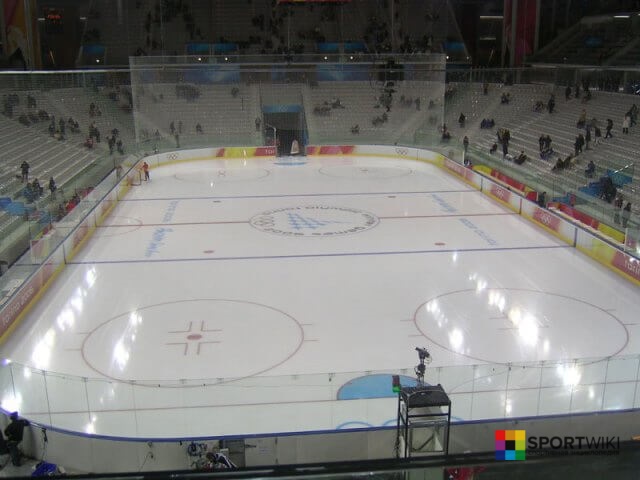
The hockey rink is equipped with two benches for the penalized players.
Ice Hockey Equipment
Hockey is a very traumatic type of sport that is why a lot of attention is paid to protective equipment.
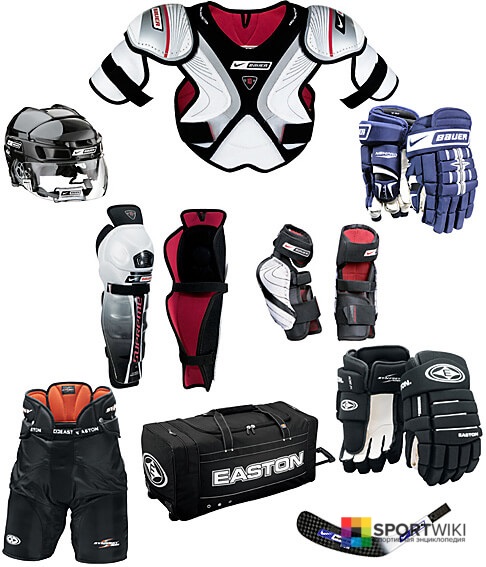
The equipment of a field player includes the following:
- A hockey stick is sports equipment with the help of which players move a puck around the rink.
- Skates are the boots with metal blades attached to them. They are used to move on the ice.
- Jockstrap is used to protect the groin area from the hit of the puck and other injuries.
- Helmet for protecting the head.
- Knee pads and elbow pads. Knee pads are designed to protect the knee joints and calves while elbow pads protect the player's elbow joints.
- Body armor provides protection to the chest and the entire back of the player.
- Gloves protect the wrists, wrist joints, and lower parts of the players’ forearms when their hands are hit by the hockey stick or by the puck.
- A mouthguard is used to prevent teeth trauma.
- Hockey shorts are designed to prevent a hockey player when he is falling, colliding, being hit by the puck, etc.
- A throat protector is a semi-rigid detail made of plastic or kevlar. It protects the throat, neck (at the front and back) and the player's collar bones.
- The sweater is an obligatory part of a hockey player's sports equipment, which is dressed on the protective equipment.
- Chaps.
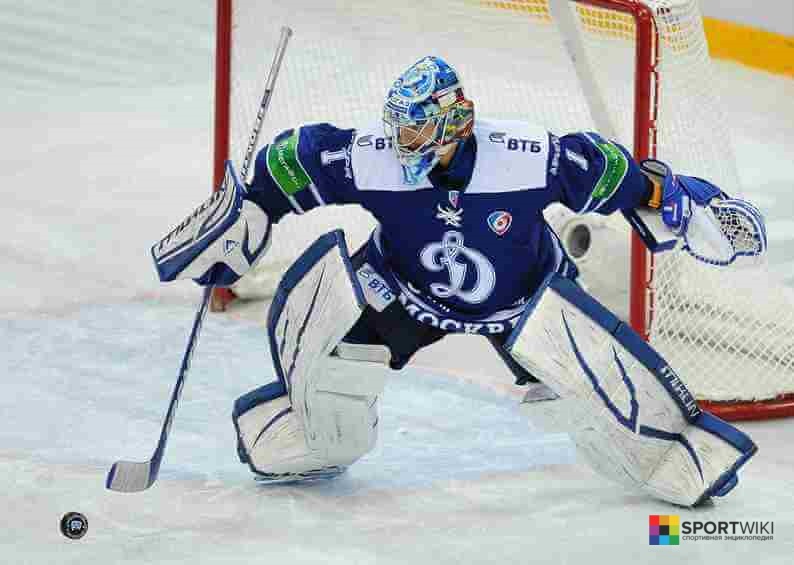
The goalminder's equipment consists of the following elements:
- Goal stick.
- Reinforced skates. They have long wide blades, plastic shock-resistant external design, shortened heel counter, special holes in the skates for attaching the shields.
- Helmet and mask.
- Throat protector.
- Body armor.
- Jockstrap is used to protect the groin area from the hit of the puck and other injuries.
- Hockey pants.
- Blocking glove (blocker) is a wide goalkeeper's glove with the places for fingers inside.
- Trapper is a glove similar to a baseball glove, but it is designed specifically for catching the puck, taking into account hockey specifics.
- Guards.
- The uniform and helmets of the players of a certain team must be of the same color (the goalminder is allowed to have a helmet that differs from the helmets of other players by its color).
- Puck.
Referees
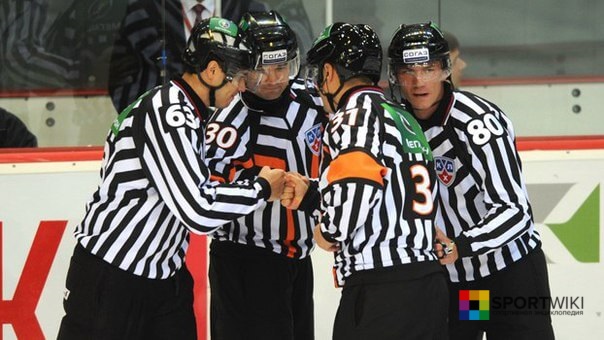
At the hockey match, there is the following referee board:
• one or two main referees;
• two lineys.
The duties of the chief referee include tracking violations of the rules and registering the scoring. Lineys are responsible for keeping track of "offside" positions, icing, violations of the numerical composition, and conducting the faceoff. In addition to the referees on the ice, in every match, there is a referee board outside the rink.
Hockey Leagues
International Ice Hockey Federation
Kontinental Hockey League
Hockey Champions League
Continental Cup
Spengler Cup

